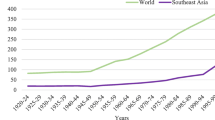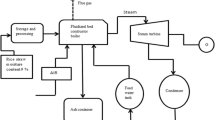Abstract
The main objective of the study is to explore the economic feasibility of power generation from rice straw, a potential biomass energy resource, in Vietnam. We calculated the potential of rice straw (as a feedstock for the production), the costs and benefits of operating a rice straw-based small power plant (10 MWe). The economic feasibility of the project was evaluated using net present value (NPV), internal rate of return (IRR), and payback period (PBP) parameters. In Vietnam, the amount of rice straw generated annually is approximately 54 million tons. In which, Kien Giang has the highest potential to produce electricity with the amount of 245 MWe/year. The study showed a NPV value of nearly 3.4 million USD, IRR 15% and 13 years of PBP over the lifetime of 20 years, suggesting that it is economically feasible to be implemented in Vietnam. It pointed out that the fuel cost accounted for the highest proportion of the total operating cost, at 49.3%. It is recommended that more specific regional parameters should be taken into account and thoroughly investigated to support decision makers in using rice straw for electricity generation.



Similar content being viewed by others
Abbreviations
- AOT:
-
Annual operating hours
- CHA:
-
Central Highlands areas of Vietnam
- C A :
-
Annuity cost
- C C :
-
Contingency cost
- C E :
-
Average employment cost
- C F :
-
Fuel cost
- C L :
-
Labour cost
- C M :
-
Maintenance and repair cost
- C U :
-
Utility cost
- FC:
-
Sum of equity and principal repayment
- IRR:
-
Internal rate of return
- LHV:
-
Low heating value
- L N :
-
Labour number
- MRD:
-
Mekong River Delta areas of Vietnam
- MW:
-
Megawatt = 106 W
- MWe:
-
Megawatts electric
- NCCC:
-
North Central and Central coastal areas of Vietnam
- NMM:
-
Northern Midlands and Mountain areas of Vietnam
- NPV:
-
Net present value
- PBP:
-
Payback period
- PPC:
-
Power plant capacity
- RSB:
-
Rice straw burning
- RISR:
-
Rice straw residue
- RRD:
-
Red River Delta areas of Vietnam
- RSdem :
-
Annual rice straw demand
- SEA:
-
South East areas
- TOC:
-
Total operating costs
- W out :
-
Electricity output
- µ :
-
Foreseen overall efficiency of the plant
References
Linh LT, Lee PP, Peng KC, Chung RH (2019) Technical and cost efficiency estimates of rice production in Vietnam: a two-stage data envelopment analysis. J Anim Plant Sci 29(1):299–305
Do PT, Ueda T, Kose R, Nguyen LX, Okayama T, Miyanishi T (2019) Properties and potential use of biochars from residues of two rice varieties, Japanese Koshihikari and Vietnamese IR50404. J Mater Cycles Waste Manag 21(1):98–106. https://doi.org/10.1007/s10163-018-0768-8
Cuong TT, Le HA, Khai NM, Hung PA, Linh LT, Thanh NV, Tri ND, Huan NX (2021) Renewable energy from biomass surplus resource: potential of power generation from rice straw in Vietnam. Sci Rep 11:792. https://doi.org/10.1038/s41598-020-80678-3
Le HA, Phuong DM, Linh LT (2020) Emission inventories of rice straw open burning in the Red River Delta of Vietnam: evaluation of the potential of satellite data. Environ Pollut 260:113972. https://doi.org/10.1016/j.envpol.2020.113972
GOS (2019) Statistical yearbook of Vietnam 2018. General Statistics Office, Statistical Publishing House, Hanoi
Le HA (2017) Emissions from rice straw burning and potential for power plants from straw in Vietnam. Technische Universitat Dresden, Germany
Sansiribhan S, Rattanathanaophat A, Nuengchaknin C (2014) Feasibility study of potential and economic of rice straw VSPP power plant in Thailand. Int J Environ Eng 8(5):1539–1541. https://doi.org/10.5281/zenodo.1092834
Le HA, Hanh NTT, Linh LT (2013) Estimated gas emission from burning rice straw in open fields in Thai Binh province. VNU J Sci Earth Environ Sci 29:26–33. https://js.vnu.edu.vn/EES/article/view/1577. Accessed 15 Jan 2021
Thang TC, Linh DTB (2014) Agricultural production policies in Vietnam. FFTC Agric Policy Artic. https://doi.org/10.2139/ssrn.3249374
IOE (2017) National biomass power development planning to 2025, vision to 2035. Institute of Energy, Ministry of Industry and Trade, Hanoi
Prime Minister (2016) Decision No. 428/QĐ-TTg: approval of the revised national power development master plan for the 2011–2020 period with the vision to 2030. http://vepg.vn/wp-content/uploads/2019/05/Decision-428-QD-TTg_PDP-7-rev_dated-18-March-2016_EN_wAnnex.pdf. Accessed 10 Dec 2020
Silalertruksa T, Gheewala SH (2013) A comparative LCA of rice straw utilization for fuels and fertilizer in Thailand. Bioresour Technol 150:412–419. https://doi.org/10.1016/j.biortech.2013.09.015
Liu B, Wu Q, Wang F, Zhang B (2019) Is straw return-to-field always beneficial? Evidence from an integrated cost-benefit analysis. Energy 171:393–402. https://doi.org/10.1016/j.energy.2019.01.031
Sajjakulnukit B, Yingyuad R, Maneekhao V, Pongnarintasut V, Bhattacharya SC, Salam PA (2005) Assessment of sustainable energy potential of non-plantation biomass resources in Thailand. Biomass Bioenergy 29:214–224. https://doi.org/10.1016/j.biombioe.2005.03.009
Prime Minister (2020) Decision 08/2020/QD-TTg: amending and supplementing several articles of the Decision 24/2014/QD-TTg (dated 23.03.2014) on the support mechanism for the development of biomass power project in Vietnam. http://vepg.vn/wp-content/uploads/2020/03/Decision_08_2020_QD-TTg_Biomass_FIT_EN.pdf. Accessed 10 Dec 2020
Lim JS, Manan ZA, Alwi SRW, Hashim H (2012) A review on utilisation of biomass from rice industry as a source of renewable energy. Renew Sust Energ Rev 16(5):3084–3094. https://doi.org/10.1016/j.rser.2012.02.051
Hanoi People’s Committee (2020) Directive 15/CT-UBND: enforcement of government management solutions on illegal burning of rice straw, agricultural solid waste to ward on reduce in advance effects to Hanoi air quality. Hanoi People’s Committee. https://thuvienphapluat.vn/van-ban/Tai-nguyen-Moi-truong/Chi-thi-15-CT-UBND-2020-quan-ly-nha-nuoc-doi-voi-hoat-dong-dot-rom-ra-khong-dung-quy-dinh-Ha-Noi-454112.aspx. Accessed 02 June 2021
Political Bureau (2020) Resolution 55-NQ/TW: strategic orientation for national energy development of Vietnam to year 2030, visions towards 2045. http://vepg.vn/wp-content/uploads/2020/03/55-NQ-phat-trien-nang-luong-quoc-gia.pdf. Accessed 2 June 2021
MOC (2019) Circular No. 07/2019/TT-BXD: amending, supplementing or replacing a number of provisions of the Minister of Construction’s Circular No. 03/2016/TT-BXD of March 10, 2016, prescribing the grading of construction works and guiding the application of construction work grades in the management of construction investment activities. https://luatvietnam.vn/xay-dung/thong-tu-07-2019-tt-bxd-bo-xay-dung-178173-d1.html. Accessed 10 Dec 2020
Cuong DM, Le HA, Co HX (2016) Emission gases calculation of rice straw open burning in Ninh Binh province for 2010–2015 period and proposal of mitigation solutions. VNU J Sci Earth Environ Sci 32:70–76. https://js.vnu.edu.vn/EES/article/view/2681. Accessed 15 Jan 2021
Delivand MK, Barz M, Gheewala SH (2011) Logistics cost analysis of rice straw for biomass power generation in Thailand. Energy 36:1435–1441. https://doi.org/10.1016/j.energy.2011.01.026
Koppejan J, Van Loo S (2012) The handbook of biomass combustion and co-firing. Routledge, London
Delivand MK, Barz M, Gheewala SH, Sajjakulnukit B (2011) Economic feasibility assessment of rice straw utilization for electricity generating through combustion in Thailand. Appl Energy 88:3651–3658. https://doi.org/10.1016/j.apenergy.2011.04.001
Zhang Q, Zhou D, Zhou P, Ding H (2013) Cost analysis of straw-based power generation in Jiangsu Province, China. Appl Energy 102:785–793. https://doi.org/10.1016/j.apenergy.2012.08.032
Diep NQ, Fujimoto S, Minowa T, Sakanishi K, Nakagoshi N (2012) Estimation of the potential of rice straw for ethanol production and the optimum facility size for different regions in Vietnam. Appl Energy 93:205–211. https://doi.org/10.1016/j.apenergy.2011.12.074
Diep NQ, Fujimoto S, Yanagida T, Minowa T, Sakanishi K, Nakagoshi N, Tran XD (2012) Comparison of the potential for ethanol production from rice straw in Vietnam and Japan via techno-economic evaluation. Int Energy J 13:113–122
Boukis I, Vasilakos N, Karellas S, Kakaras E (2008) Techno-economic analysis of the energy exploitation of biomass residues in Heraklion Prefecture—Crete. Renew Sustain Energ Rev 13(2):362–377. https://doi.org/10.1016/j.rser.2007.10.006
Caputo AC, Palumbo M, Pelagagge PM, Scacchia F (2005) Economics of biomass energy utilization in combustion and gasification plants: effects of logistic variables. Biomass Bioenergy 28:35–51. https://doi.org/10.1016/j.biombioe.2004.04.009
MOF (2015) Guidelines for corporate income tax in the government’s decree no. 12/2015/ND-CP dated February 12, 2015 on guidelines for the law on amendments to laws on taxation and amendments to degrees on taxation; amendments to some articles of circular no. 78/2014/TT-BTC dated June 18, 2014, circular no. 119/2014/TT-BTC dated august 25, 2014, and circular no. 151/2014/TT-BTC dated October 10, 2014. Vietnam Ministry of Finance. https://thuvienphapluat.vn/van-ban/Doanh-nghiep/Thong-tu-96-2015-TT-BTC-huong-dan-thue-thu-nhap-doanh-nghiep-tai-Nghi-dinh-12-2015-ND-CP-279331.aspx. Accessed 10 Dec 2020
Tuong TP, Hoanh CT, Khiem NT (1991) Agro-hydrological factors as land qualities in land evaluation for rice cropping patterns in the Mekong Delta of Vietnam. In: Ponnamperuma D, Nelson F (eds) Rice production on acid soils of the tropics. Institute of Fundamental Studies, Kandy, pp 23–30
Acknowledgements
This research was funded by the Vietnam National Foundation for Science and Technology Development (NAFOSTED) under Grant number 105.08-2018.04.
Author information
Authors and Affiliations
Corresponding author
Additional information
Publisher's Note
Springer Nature remains neutral with regard to jurisdictional claims in published maps and institutional affiliations.
Rights and permissions
About this article
Cite this article
Le, H.A., Thu, D.H. & Khoi, N.Q. Rice straw-base power generation: a potential and economic cost–benefit analysis for a small power plant (10 MWe) in Vietnam. J Mater Cycles Waste Manag 23, 2232–2241 (2021). https://doi.org/10.1007/s10163-021-01289-2
Received:
Accepted:
Published:
Issue Date:
DOI: https://doi.org/10.1007/s10163-021-01289-2




